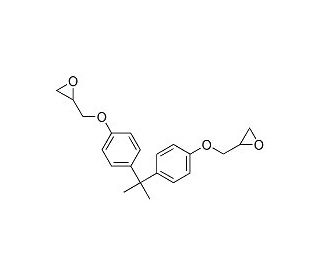

Molecular structure of BADGE, CAS Number: 1675-54-3
BADGE (CAS 1675-54-3)
See product citations (3)
Alternate Names:
Bisphenol A diglycidyl ether; 2,2′-[(1-Methylethylidene)bis(4,1-phenyleneoxymethylene)]bis-oxirane
Application:
BADGE is an inhibitor of PPARγ and suppressor of TNFα
CAS Number:
1675-54-3
Purity:
≥85%
Molecular Weight:
340.41
Molecular Formula:
C21H24O4
For Research Use Only. Not Intended for Diagnostic or Therapeutic Use.
* Refer to Certificate of Analysis for lot specific data.
QUICK LINKS
Ordering Information
Product Citations
Description
Technical Information
Safety Information
SDS & Certificate of Analysis
BADGE, or Bisphenol A diglycidyl ether, is an epoxy resin that is found in dental sealants and thermal paper. BADGE is synthesized through the reaction of bisphenol A with epichlorohydrin, resulting in a compound with two epoxide groups. These epoxide groups allow BADGE to crosslink with other molecules, giving it its characteristic strength and durability. BADGE is used as a stabilizer in PVC plastics and as an antioxidant in rubber. Despite its widespread use, concerns have been raised about the potential health effects of BADGE, particularly its potential to act as an endocrine disruptor.
BADGE (CAS 1675-54-3) References
- A synthetic antagonist for the peroxisome proliferator-activated receptor gamma inhibits adipocyte differentiation. | Wright, HM., et al. 2000. J Biol Chem. 275: 1873-7. PMID: 10636887
- Migration of bisphenol-A diglycidyl ether (BADGE) and its reaction products in canned foods. | Hammarling, L., et al. 2000. Food Addit Contam. 17: 937-43. PMID: 11271708
- Bisphenol A diglycidyl ether induces apoptosis in tumour cells independently of peroxisome proliferator-activated receptor-gamma, in caspase-dependent and -independent manners. | Fehlberg, S., et al. 2002. Biochem J. 362: 573-8. PMID: 11879183
- Bisphenol a diglycidyl ether (BADGE) suppresses tumor necrosis factor-alpha production as a PPARgamma agonist in the murine macrophage-like cell line, RAW 264.7. | Nakamuta, M., et al. 2002. Cell Biol Int. 26: 235-41. PMID: 11991651
- Induction of apoptosis in human and rat glioma by agonists of the nuclear receptor PPARgamma. | Zander, T., et al. 2002. J Neurochem. 81: 1052-60. PMID: 12065618
- Review of the toxicology, human exposure and safety assessment for bisphenol A diglycidylether (BADGE). | Poole, A., et al. 2004. Food Addit Contam. 21: 905-19. PMID: 15666984
- Cytotoxic effects of BADGE (bisphenol A diglycidyl ether) and BFDGE (bisphenol F diglycidyl ether) on Caco-2 cells in vitro. | Ramilo, G., et al. 2006. Arch Toxicol. 80: 748-55. PMID: 16783546
- BADGE, a synthetic antagonist for PPARγ, prevents steroid-related osteonecrosis in a rabbit model. | Yuan, N., et al. 2018. BMC Musculoskelet Disord. 19: 129. PMID: 29703208
- BPA, BADGE and analogues: A new multi-analyte LC-ESI-MS/MS method for their determination and their in vitro (anti)estrogenic and (anti)androgenic properties. | van Leeuwen, SP., et al. 2019. Chemosphere. 221: 246-253. PMID: 30640007
- Bisphenol A Diglycidyl Ether (BADGE) and Bisphenol Analogs, but Not Bisphenol A (BPA), Activate the CatSper Ca2+ Channel in Human Sperm. | Rehfeld, A., et al. 2020. Front Endocrinol (Lausanne). 11: 324. PMID: 32508751
- Bisphenol A Diglycidyl Ether (BADGE) and Progesterone Do Not Induce Ca2+ Signals in Boar Sperm Cells. | Rehfeld, A., et al. 2020. Front Physiol. 11: 785. PMID: 32774306
- LC-MS/MS analysis of BADGE, NOGEs, and their derivatives migrated from food and beverage metal cans. | Hwang, JB., et al. 2020. Food Addit Contam Part A Chem Anal Control Expo Risk Assess. 37: 1974-1984. PMID: 32960157
- Urinary biomonitoring of occupational exposures to Bisphenol A Diglycidyl Ether (BADGE) - based epoxy resins among construction painters in metal structure coating. | Bello, A., et al. 2021. Environ Int. 156: 106632. PMID: 34020298
- A comprehensive review on the analytical method, occurrence, transformation and toxicity of a reactive pollutant: BADGE. | Wang, D., et al. 2021. Environ Int. 155: 106701. PMID: 34146765
Inhibitor of:
ABCG8, ABHD5, ACBD6, Angptl7, PECR, Peroxin 13, PPARα, and PRC.Activator of:
BC030867.Ordering Information
| Product Name | Catalog # | UNIT | Price | Qty | FAVORITES | |
BADGE, 25 g | sc-202487 | 25 g | $38.00 | |||
BADGE, 50 g | sc-202487A | 50 g | $50.00 | |||
BADGE, 100 g | sc-202487B | 100 g | $63.00 | |||
BADGE, 500 g | sc-202487C | 500 g | $189.00 |
